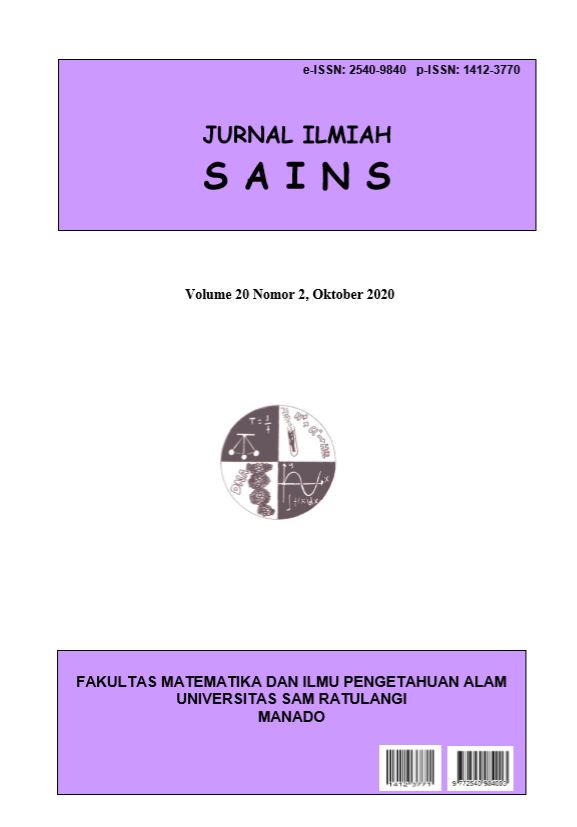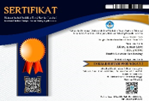Analisis Fitokimia dan Uji Toksisitas Daun Leleng Merah (Graptophyllum pictum (L.) Griffith) dengan Metode Brine Shrimp Lethality Test
DOI:
https://doi.org/10.35799/jis.20.2.2020.30069Abstract
Penelitian ini bertujuan untuk menentukan total phenolic content (TPC), total flavonoid content (TFC), condensed tannin content (CTC) dan nilai toksisitas dari daun leleng merah. Daun leleng merah diekstraksi dengan metode maserasi dan dipartisi menggunakan pelarut n-heksana, etil asetat, dan air. Penentuan nilai TPC menggunakan metode Folin-Ciocalteu. Penentuan nilai TFC menggunakan metode AlCl3. Penentuan nilai CTC menggunakan metode vanillin-HCl. Penentuan nilai toksisitas menggunakan metode BSLT. Nilai TPC yang diperoleh pada fraksi n-heksana (FH), fraksi air (FA), dan fraksi etil asetat (FEA) daun Leleng Merah berturut-turut, adalah: 20,48; 31,7; dan 37,57 (mg/g). Nilai TFC diperoleh pada FH, FA, dan FEA berturut-turut, adalah: 0,64; 0,99; dan 1,27 (mg/g). Nilai CTC diperoleh pada FH, FA, dan FEA berturut-turut, adalah: 0,56; 2,17; dan 6,52 (mg/g). Nilai toksisitas diperoleh pada FEA, FA, FH berturut-turut, adalah: 21,93; 100,7; dan 117,22 (mg/L). FEA memiliki nilai toksisitas dan kandungan fitokimia tertinggi. Daun leleng merah bersifat toksik.
Kata Kunci : Brine shrimp lethality test, leleng merah, fitokimia,
 Phytochemical Analysis and Toxicity Test of Leleng Merah Leaves (Graptophyllum pictum (L.) Griffith) Using the Brine Shrimp Lethality Test
 ABSTRACT
This study aims to determine the total phenolic content (TPC), flavonoids (TFC), condensed tannins (CTC) and toxicity value of Leleng Merah leaves. Leleng merah leaves were extracted by maceration method and partitioned using n-hexane, ethyl acetate, and water solvent. TPC values were determined using the Folin-Ciocalteu method. TFC values were determined using the AlCl3 method. CTC values were determined using the vanillin-HCl method. Toxicity values were determined using the BSLT method. TPC values obtained in the n-hexane (FH), water (FA), and ethyl acetate (FEA) fraction of the Leleng Merah leaves, were: 20.48; 31.7; 37.57 (mg / g) respectively. TFC values obtained in FH, FA, and FEA, were : 0.64; 0.99; 1.27 (mg / g) respectively. CTC values obtained at FH, FA, FEA, were: 0.56; 2.17;Â 6.52 (mg/g) respectively. Toxicity values obtained at FEA, FA, FH, were: 21.93; 100.7; 117.22 (mg/L) respectively. FEA has the highest toxicity and phytochemical content. Leleng Merah Leaf is toxic.
Keywords : Brine Shrimp Lethality Test, leleng merah, phytochemistry
References
Conde, E.F., M.C. Cadahia, B.F.D. GarciaVallejo, J.R.G. Adrabos & Simon. 1997. Low Molecular Weight Polyphenols in Cork of Quercus Suber. Journal Agricultural and Food Chemistry, 45(7): 2695-2700.
Dencic, M.S., J. Poljarevic & U. Vilimanovich. 2012. Cyclohexyl Analogues of Ethylenediamine Dipropanoic Acid Induce Caspase-Independent Mitochondrial Apoptosis in Human Leukemic Cells. Chemical Research in Toxicology, 25(4): 31-39.
Julkunen-Tiitto, R. 1985. Phenolic Constituents in Leaves of Northern Willows: Methods for The Analysis of Certain Phenolics. Journal of Agricultural and Food Chemistry, 33(2): 213-217.
Manik, D.F., T. Hertiani & H. Anshory. 2014. Analisis Korelasi Antara Kadar Flavonoid dengan Aktivitas Antibakteri Ekstrak Etanol dan Fraksi-Fraksi Daun Kersen (Muntingia calabura L.) Terhadap Staphylococcus aureus. Khazanah, 6(2):1-11.
Meda, A., C.E. Lamein, M. Romito, J. Milliogo & O.G. Nacoulina. 2005. Determination of the Total Phenolic, Flavonoid and Proline Content in Burkina Fasan Honey, As Well As Their Radical Scavenging Activity. Journal of Food Chemistry, 91(1): 571-577.
Meyer, B.N., N.R. Ferrigni, J.E. Putnam, L. B. Jacobsen, D.E. Nichols & J.E. McLaughlin. 1982. Brine Shrimp: A Convenient General Bioassay for Active Plant Constituents. Planta Medica, 45(5): 31-34.
Michałowicz, J. & W. Duda. 2007. Phenols – Sources and Toxicity. Polish Journal of Environment Study, 16(3): 347-362.
Nandi, S., M. Vracko & M.C. Bagchi. 2007. Anticancer Activity of Selected Phenolic Compounds: QSAR Studies Using Ridge Regression and Neural Networks. Chem Biol Drug. 70(5): 424–43.
Pangow, M.E., W. Bodhi & E. de Queljoe. 2018. Skrining Fitokimia dan Uji Toksisitas dari Ekstrak Etanol Daun Manggis (Garcinia mangostana L.) dengan Metode Brine Shrimp Lethality Test (BSLT). Pharmacon, 7(3): 97-107.
Rambi, G.A.D., V.S. Kamu & M.R.J. Runtuwene. 2016. Uji Fitokimia dan Antioksidan dari Daun Yantan (Blumea chinensis DC). Jurnal MIPA UNSRAT Online, 5(1): 32-35.
Ren, W., Q. Zhenhua, W. Hongwei, Z. Lei & Z. Lie. 2003. Flavonoid: Promising Anticancer Agents. Department of Hematology, 2nd Hospital of Shanxi Medical University, Taiyuan.
Rohman, A., S. Riyanto & D. Utari. 2006. Antioxidant Activities, Total Phenolic and Flavonoid Contents of Ethyl Acetate Extract of Mengkudu (Morinda citrifolia, L) Fruit and Its Fractions. Majalah Farmasi Indonesia, 17(3): 136-142.
Rosamah, E., H.M.R. Awaliyan & E. Sukaton. 2017. Karakteristik Tanin dari Ekstrak Kulit Kayu Leda (Eucalyptus deglupta Blume.). Jurnal Hutan Tropis, 1(1): 16-28.
Scheuer, J.S. 1994. Produk Alami Lautan. IKIP Semarang Press, Semarang.
Sultana, N., A.R. Alimon, K.S. Haque, A.Q. Sazili, H. Yaakub & S.M.J Hossain. 2014. The Effect of Cutting Interval on Yield and Nutrient Composition of Different Plant Fractions of
Moringa Oleifera Tree. Journal Food and Agricultural Environment, 12(2): 599-604.
Yildirim, I. & T. Kutlu. 2015. Anticancer Agents: Saponin and Tannin. International Journal of Biological Chemistry, 9(6): 332-340.







